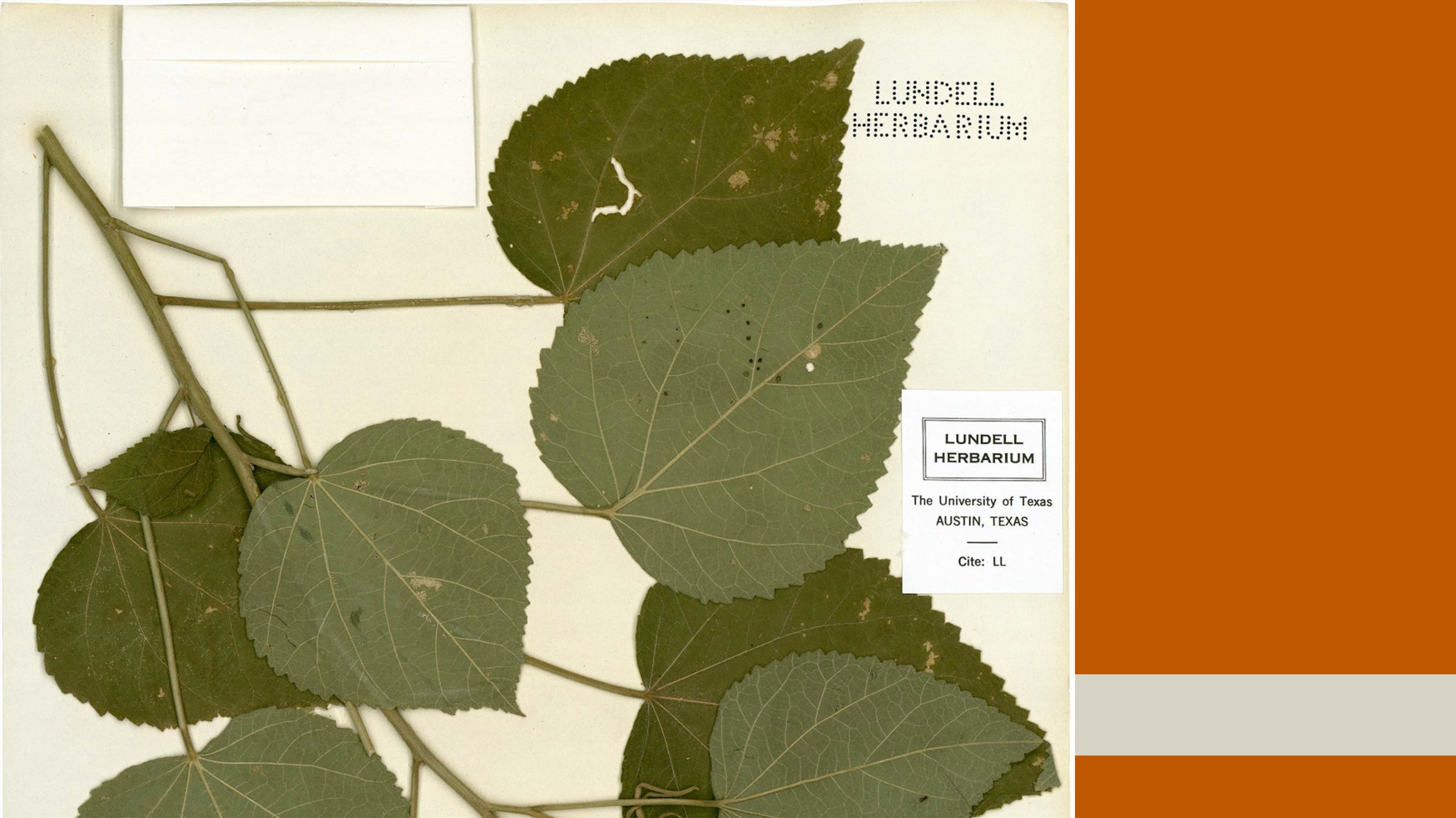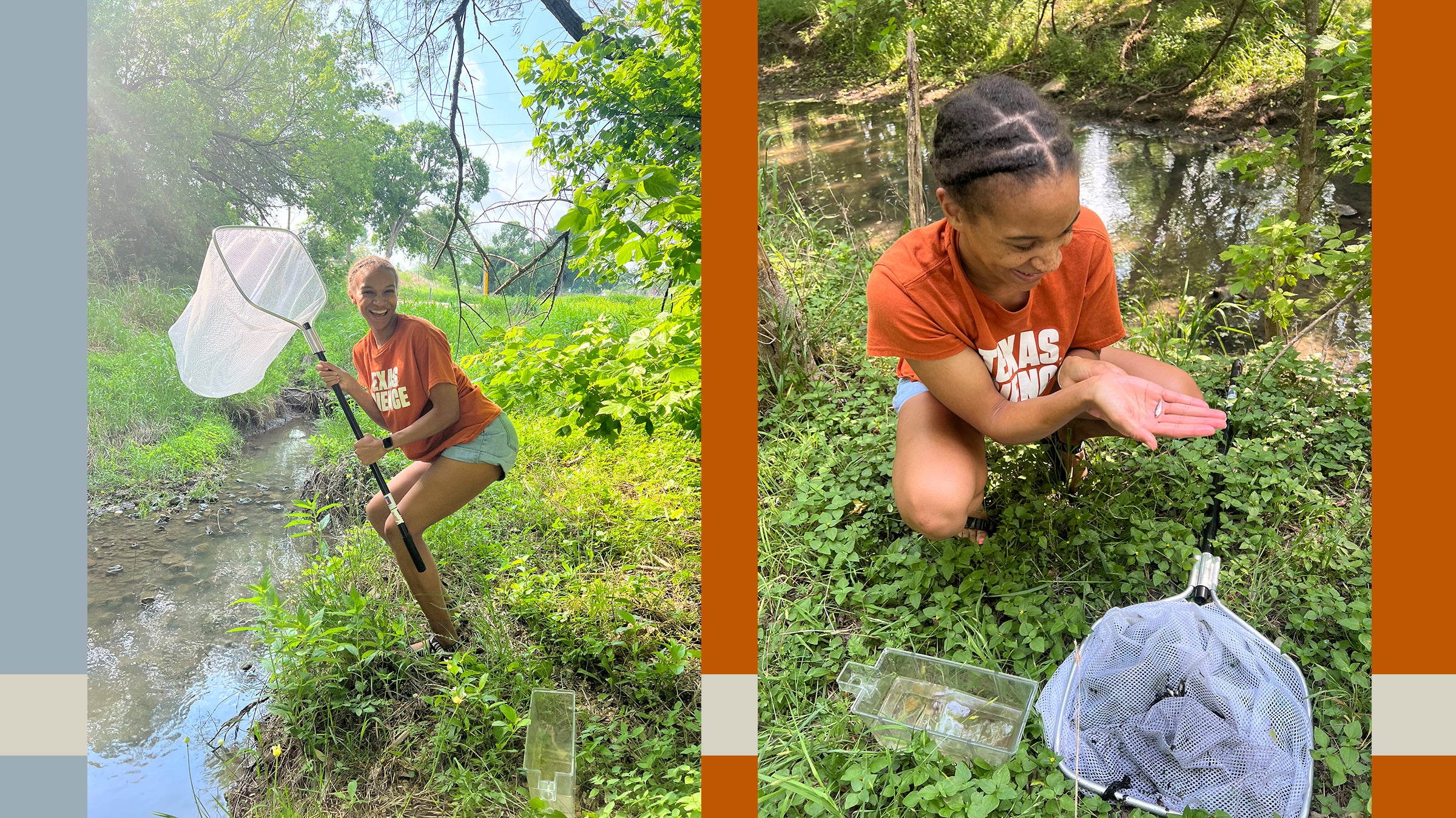
Section of Lundell Herbarium 1964 specimen of Hibiscus lasiocarpus Cav.
Few landmarks on the UT campus are as iconic as the Tower, visible to thousands daily as part of the Austin skyscape. Yet, not many people realize that eight different floors of the Tower contain over one million plant specimens, all belonging to the Billie L. Turner Plant Resources Center (PRC), one of the largest herbaria in the southwest United States.
UT's herbarium (TEX) started with a collection of plants made in the 1890s by Frederick W. Simonds, a professor of geology. The collection grew, but only slightly, when Adjunct Professor William L. Bray added 500 specimens collected in Texas in 1899 during a six-week leave of absence.
The first person officially responsible for curating the herbarium was Dr. Mary Sophie Young (1872-1919), who became a tutor at UT in 1910 and took charge of the collection in 1912. Dr. M.S. Young, as she liked to be called, began the first substantial increase in the collection. She traveled extensively in west Texas, collecting in the Guadalupe, Chinati, Davis, and Chisos mountains. Young died from cancer at the age of 46 on March 5, 1919, but during her brief seven years as curator, she increased the herbarium holdings from 2500 specimens to 16,000.
The first university-appointed Director of the herbarium was Dr. Benjamin Carroll Tharp, who also curated the herbarium from 1919 until the mid 1950s. Tharp (1885-1964) was an instructor of Botany at UT in 1919, Associate Professor in 1925, and Full Professor from 1933 to 1956. Tharp's extensive writings on Texas botany were often utilized by authors and artists, in both historical works and short fiction. Tharp's efforts increased the collection from 16,000 to 200,000 specimens.

Left: B.C. Tharp in 1961 (photo by Alan Graham) Right: Fred Barkley in 1943 (source unknown)
When the Biological Laboratories building was completed in 1925, the herbarium moved onto the 4th floor of that building. Dr. Fred A. Barkley curated the herbarium beginning in 1942 but remained in this position only a short time until 1947.
In 1958, the Directorship of the herbarium was taken on by Dr. Billie Turner, opening another period of expansive growth in the collection. In 1961, Marshall C. Johnston joined the botany faculty and he, Turner, and their students increased the holdings of the herbarium by 100,000 sheets, bringing the total to about 300,000 specimens by 1978.
As the size, reputation, and usage of the herbarium increased during Dr. Turner’s directorship, the university established a Ph.D. level staff Curator position to run the day-to-day operations of the herbarium, allowing the Director, a tenured faculty member, to maintain his academic obligations as well as the administrative duties for the collection. This position was first filled by Dr. Jackie Poole (1976-1982) and then by Dr. Barbara Ertter (1982-1985). Dr. Turner, while Director, negotiated with Dr. Cyrus L. Lundell for the eventual transfer of Dr. Lundell’s private herbarium (LL) to The University of Texas to form a combined collection under the title of the Plant Resources Center. Lundell’s collection contained a rich diversity of specimens from Texas and Central America, especially from Mexico, Honduras, Guatemala, and Belize. Dr. Lundell (1907-1994) at the time was a professor at the University of Texas at Dallas who had an interest not only in botany, but also in archeology and Maya culture. While working in Honduras at the Tropical Plant Research Foundation, he located the Maya city of Calakmul in 1931, a city that had been hidden in the jungle for some 1000 years.

The transfer of Lundell's 320,000 specimens to UT and the move, overseen by Barbara Ertter, of the entire combined herbaria into the UT Tower was completed in 1990. When combined with the 500,000 specimens at that time in the UT herbarium, the PRC (TEX-LL) became one of the most important plant collections in the United States. After this merger, the PRC continued to hire a staff Curator to assist the Director: Dr. Guy Neson (1987-1995), Dr. Tom Wendt (1996-2015), and, most recently, Dr. George Yatskievych (2015-present). In addition to his herbarium, Dr. Lundell endowed a C. L. Lundell Professorship of Systematic Botany, a second for partial maintenance of the herbarium, and a third for the publication of a journal to be titled Lundellia. During Dr. Turner’s Directorship, the Doris and Sidney Blake Professorship in Systematic Botany was also established following the death of Doris Blake. Turner was subsequently appointed as the first Blake Professor.
In 2000, Dr. Beryl Simpson became the Director of the Plant Resources Center and first C. L. Lundell Chair. While Director, she pushed the collection into the digital age by leading the effort to make an online database of all Texas specimens. By 2016, all type specimens, Texas specimens, and most Mexican specimens had been made available digitally, due to the efforts of Dr. José Panero. Simpson served as Director of the Plant Resource Center until 2016 when, upon her retirement, Dr. Robert Jansen, the second Blake Professor, assumed directorship. In 2017, the Plant Resource Center was named the Billie L. Turner Plant Resources Center by an act of the UT Regents. Dr. Turner's death in 2020 left another substantial endowment.

Ferdinand Lindheimer from Goethe im Lichte der Verebungslehre - 1908
Dr. Panero currently serves as the Associate Director. Most recently, the herbaria became a part of the new Biodiversity Center, along with the zoological collections, under the Department of Integrative Biology.
As of 2022, the collection continues to expand by about 7000 additional specimens annually. These new accessions originate from exchanges of duplicates with other herbaria around the world, donations from researchers, and occasionally the salvage of other herbaria that have become orphaned by their home institutions. Research is defined in the broadest sense to include faculty and student projects, vouchers for work by state and federal agency biologists and environmental consultants, and citizen science projects. An example of a salvaged herbarium is the ca. 14,000 specimen Runyon Herbarium from the UT Rio Grande Valley campus in Brownsville, which was donated to Plant Resources Center in 2021. The Plant Resources Center is especially strong in the representation of the sunflower family (Asteraceae), with over 200,000 specimens. Among the older specimens in the collection which date as far back as the 1760s, there are collections made on famous expeditions, such as Captain Cook’s first voyage and Charles Darwin’s Voyage of the Beagle. Additionally, over 600 specimens are among those collected in the mid-1800s by "The Father of Texas Botany," Ferdinand Lindheimer. Such historical collections long-predate the founding of the University of Texas (the oldest even predate Texas statehood!) and were all received as gifts from other museums.
Simpson, Beryl, correspondence.
Fry Cortez, Dyanne. “The Plant Gatherer.” Texas Parks and Wildlife, January-February, 2013.
Graham, Alan. "Benjamin Carroll Tharp (1885-1964) Remembering a Life Fashioned of Events and Circumstances." Lundellia, 13:3-9. 2010
Patterson, John Thomas. "History of Biology in the University of Texas." Reprinted from the University of Texas Bulletin, No. 2545, University of Texas Press, 1925.
"History," Plant Resources Center at The University of Texas at Austin, accessed online (http://w3.biosci.utexas.edu/prc/history.html)
“Plant Resources Center,” Wildflowers of Texas, accessed online (http://www.lib.utexas.edu/exhibits/wildflowers/prc.html)
“University of Texas at Austin Herbarium” JSTOR Plants, accessed online (https://plants.jstor.org/partner/TEX)
Yatskievych, George, correspondence.



